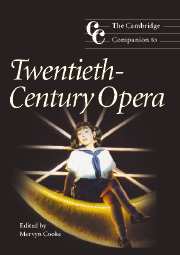Book contents
- Frontmatter
- Part one Legacies
- Part two Trends
- Part three Topographies
- 8 France and the Mediterranean
- 9 Austria and Germany, 1918–1960
- 10 Eastern Europe
- 11 Russian opera: between modernism and romanticism
- 12 American opera: innovation and tradition
- 13 Opera in England: taking the plunge
- Part four Directions
- General index
- Index of operas
9 - Austria and Germany, 1918–1960
from Part three - Topographies
Published online by Cambridge University Press: 28 September 2011
- Frontmatter
- Part one Legacies
- Part two Trends
- Part three Topographies
- 8 France and the Mediterranean
- 9 Austria and Germany, 1918–1960
- 10 Eastern Europe
- 11 Russian opera: between modernism and romanticism
- 12 American opera: innovation and tradition
- 13 Opera in England: taking the plunge
- Part four Directions
- General index
- Index of operas
Summary
Just over 14 years went by between the end of the First World War and the Nazis' seizure of power, a short span for the high cultural repute Weimar culture has been accorded in twentieth-century popular and academic imagination – a repute particularly relevant to Berlin, which is still deriving much of its fragile self-confidence from that mythical decade. Opera is part and parcel of these images, but in a limited sense: we think of Bertolt Brecht and Kurt Weill, the Golden Boys of the Golden Twenties, of Die Dreigroschenoper (1928), Aufstieg und Fall der Stadt Mahagonny (1930) or Paul Hindemith's Neues vom Tage (1929); we think of the Kroll Opera and its controversial productions under the musical direction of Otto Klemperer; we think of a pointedly urban, sassy modernity. But it may be the range of personalities and events rather than any couleur locale that made Berlin such a musical hotbed at the time. There was the premiere of Alban Berg's Wozzeck in 1925; there were the antagonistic figures of Ferruccio Busoni and Hans Pfitzner, both teaching masterclasses at the Academy of Music since 1920; there was their superior, Academy director Franz Schreker, who had come from Vienna in the same year; there was Hindemith, who joined the Academy as a professor in 1927; there was Alexander Zemlinsky, who came from Prague in the same year to conduct at the Kroll Opera and taught from 1931 to 1933 at the Academy of Arts – composers with wildly different approaches to opera, embodying a disintegration of stylistic common ground that is the main characteristic of twentieth-century music.
- Type
- Chapter
- Information
- The Cambridge Companion to Twentieth-Century Opera , pp. 146 - 164Publisher: Cambridge University PressPrint publication year: 2005
- 1
- Cited by



